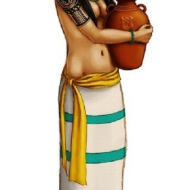Lakapati : The Transgender Goddess
Listen
At a glance
| Description | |
|---|---|
| Origin | Philippine Mythology |
| Classification | Gods |
| Family Members | Bathala (Husband), Mapulon (Husband), Anagolay (Daughter) |
| Region | Philippines |
| Associated With | Transgenders, Abundance, Agriculture |
Lakapati
Introduction
Lakapati, a revered figure in Tagalog mythology, is distinct not only for their role but also their unique nature. They embody fertility, agriculture, and the bountiful harvests that sustain communities. What sets Lakapati apart is their depiction as a transgender or intersex deity, reflecting the acceptance and inclusivity of pre-colonial Philippine society. Known as the kindest and most understanding deity among the Philippine pantheon, Lakapati is revered for their role in providing prosperity and food, ensuring fertility in fields and health in livestock.
In ancient times, Lakapati was widely regarded as a great mother goddess, often depicted as both male and female, symbolizing a transgender deity. People prayed to Lakapati for protection from hunger, offering rice, herbs, and plants during full moons. Statues and carved figures of Lakapati were carried and worshipped as symbols of reverence. In Philippine mythology, Lakapati stands out as a nurturing deity of fertility and agriculture, embodying the deep connection between humanity and nature.
Physical Traits
Descriptions of Lakapati’s physical form vary, portraying them in different ways. Some depict Lakapati as a beautiful hermaphrodite, possessing both male and female characteristics. Others emphasize a more feminine appearance, highlighting the concept of embodying a harmonious balance between genders. This fluidity in portrayal reflects the absence of rigid gender binaries in the ancient Tagalog worldview. Lakapati is often depicted with a serene countenance and a nurturing demeanor, symbolizing a gender-fluid deity who embodies both masculine and feminine traits. Adorned with symbols of abundance and fertility, such as ears of rice or overflowing baskets of crops, Lakapati exudes a sense of prosperity and sustenance, embodying the balance of nature as both a mother figure and a provider.
Family
Within the pantheon of Philippine mythology, Lakapati plays diverse roles alongside various deities. They are sometimes depicted as the consort of Idiyanale, the goddess of labor and industry, symbolizing the interdependence between human effort and agricultural abundance. In other accounts, Lakapati is portrayed as the partner of Bathala, the supreme god, who is also described with transgender characteristics. According to these myths, Lakapati plays a pivotal role in creation, offering Bathala a clay and banana blossom ball that forms the foundation of the world.
Additionally, Lakapati is associated with Mapulon, the god of seasons, in narratives highlighting their partnership in ensuring the fertility and renewal of the land. In yet another perspective, Lakapati is considered the parent of Anagolay, the goddess of lost things, symbolizing fertility’s broader implications beyond the physical realm. These varied depictions underscore Lakapati’s significance as a deity intertwined with creation, fertility, and the cyclical abundance of life in Filipino folklore.
Other names
Lakapati is known by various names across different regions of the Philippines, including Ikapati and Lakandiwa, each reflecting nuances of fertility and agricultural abundance. These variations highlight the diverse cultural landscape and localized interpretations of divine entities within different communities. The name Lakapati derives from the words “Lakan,” meaning “lord” or “master,” and “Pati,” meaning “giver,” emphasizing their role as a provider of sustenance. Ikapati similarly shares this root, but often leads to confusion, as Ikapati is sometimes referred to as a goddess, while Lakapati is known to be androgynous. These name variations capture the essence of life-giving power and agricultural prosperity, illustrating the importance of Lakapati in the ancient culture of the Filipino people.
Powers and Abilities
As the deity of fertility and agriculture, Lakapati wields formidable powers related to nurturing and growth. They are believed to influence the fertility of the land, ensuring bountiful harvests and prosperous seasons. Farmers and communities often offered prayers and rituals to Lakapati, seeking blessings for their crops and livestock. This reverence underscores Lakapati’s role as a protector and benefactor of agricultural endeavors.
Lakapati’s influence extended beyond crops, also encompassing the health and fertility of farm animals, crucial for the livelihood of agricultural communities. Some accounts even suggest Lakapati played a role in human fertility, further solidifying their association with abundance and the continuation of life. During full moons, offerings such as plates of rice were made to symbolize dependence on Lakapati’s generosity. Ceremonial chants, often involving the offering of a child, were also performed, expressing the community’s hope for sufficient sustenance. This deity’s profound control over crop growth and harvests ensured that the people had enough to eat, reinforcing their role as a guardian of life’s cycles.
Modern Day Influence
The Kambal Tuko, or Siamese twins, symbolizes Lakapati in mythology and is referred to as anting-anting. This symbol also represents Eve and Adam and is believed to be a fertility talisman for couples. Popular among those wishing for children, the Kambal Tuko might be a reinterpretation of Lakapati’s idol, as depicted by the artist Buenaventura, presenting a male/female image as a singular entity. Today, Lakapati’s legacy endures in agricultural rituals and folk practices, invoked for a bountiful harvest and as a protector against famine and drought, integrating into modern cultural expressions that celebrate the connection between humans and nature.
In contemporary society, the reverence for Lakapati is intertwined with ecological awareness and sustainable practices. Efforts to promote organic farming, environmental conservation, and community agriculture draw inspiration from the principles of balance and harmony embodied by Lakapati. Their influence extends beyond agriculture into broader cultural spheres, symbolizing resilience and interconnectedness. Artisans, poets, and storytellers continue to weave Lakapati’s mythos into contemporary literature, art, and performances, reinforcing the intrinsic bond between humanity and the natural world.
Lakapati also represents a celebration of diversity and acceptance, challenging traditional gender norms and promoting inclusivity. The LGBTQ+ community in the Philippines has embraced Lakapati’s image as a powerful symbol of gender diversity and the fight for equal rights. Preserving Lakapati’s story is crucial for maintaining the rich tapestry of Philippine mythology, connecting Filipinos to their cultural heritage and the values that shaped their ancestors’ worldview. In the face of modern environmental challenges, Lakapati’s association with agriculture underscores the need for sustainable practices and respect for nature. Their legacy serves as a source of inspiration, advocating for a more inclusive and sustainable future.
Related Images
Frequently Asked Questions
Who is the husband of Lakapati?
Lakapati’s marital status reflects the fluidity of gender roles in ancient Tagalog society. Sometimes seen as the consort of the supreme deity Bathala, who also embodied transgender characteristics, Lakapati could also be depicted as partnered with Mapulon, the god of seasons. This reflects a focus on harmony and the interconnectedness between Lakapati’s power over fertility and Mapulon’s influence on the cycles that sustain it.
What are the myths of lakapati?
Lakapati’s myths weave a tapestry of creation, partnership, and abundance. In some tales, they contribute to the world’s formation alongside a supreme god. Other stories depict Lakapati’s vital partnership with the god of seasons, ensuring bountiful harvests. Lakapati’s role extends beyond physical fertility, with some myths portraying them as the parent of the goddess of lost things, highlighting their connection to abundance in all its forms.
What is the gender of Lakapati?
Lakapati transcends traditional gender definitions. Described as transgender, intersex, or androgynous, Lakapati embodies a harmonious blend of masculine and feminine characteristics. This fluidity reflects the acceptance of diverse gender identities in pre-colonial Philippine society.
Is ikapati and lakapati the same?
Ikapati and Lakapati are two names for the same benevolent deity in Tagalog mythology. Lakapati is the more commonly used term, highlighting their nobility and power as the provider. Ikapati might lean towards the aspect of giving, with its root word meaning “giver.” Both names ultimately represent the same figure who embodies fertility and agricultural abundance.
What does the Lakapati symbolize?
Lakapati is a rich tapestry of symbolism. They embody the abundance of the harvest, challenging traditional gender norms with their fluidity. This reflects a society that valued balance, harmony with nature, and the benevolence of a generous deity who ensured life’s continuation.














